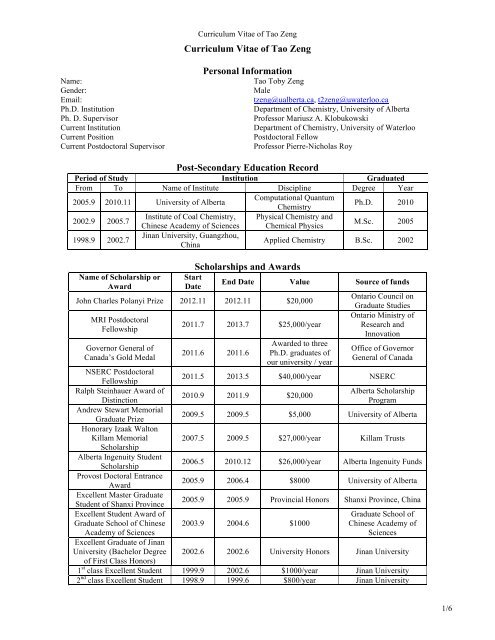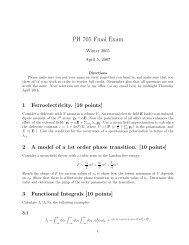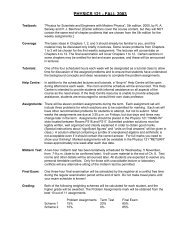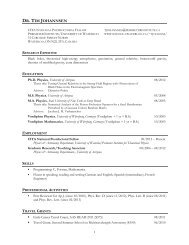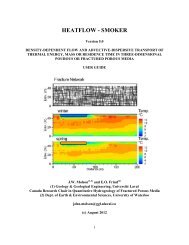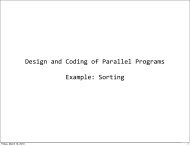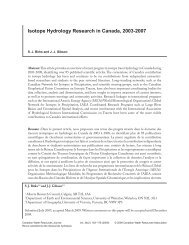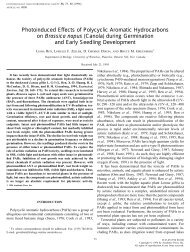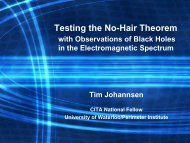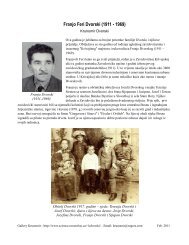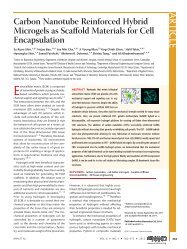Toby Zeng - University of Waterloo
Toby Zeng - University of Waterloo
Toby Zeng - University of Waterloo
Create successful ePaper yourself
Turn your PDF publications into a flip-book with our unique Google optimized e-Paper software.
Curriculum Vitae <strong>of</strong> Tao <strong>Zeng</strong><br />
Curriculum Vitae <strong>of</strong> Tao <strong>Zeng</strong><br />
Name:<br />
Gender:<br />
Email:<br />
Ph.D. Institution<br />
Ph. D. Supervisor<br />
Current Institution<br />
Current Position<br />
Current Postdoctoral Supervisor<br />
Personal Information<br />
Tao <strong>Toby</strong> <strong>Zeng</strong><br />
Male<br />
tzeng@ualberta.ca, t2zeng@uwaterloo.ca<br />
Department <strong>of</strong> Chemistry, <strong>University</strong> <strong>of</strong> Alberta<br />
Pr<strong>of</strong>essor Mariusz A. Klobukowski<br />
Department <strong>of</strong> Chemistry, <strong>University</strong> <strong>of</strong> <strong>Waterloo</strong><br />
Postdoctoral Fellow<br />
Pr<strong>of</strong>essor Pierre-Nicholas Roy<br />
Post-Secondary Education Record<br />
Period <strong>of</strong> Study Institution Graduated<br />
From To Name <strong>of</strong> Institute Discipline Degree Year<br />
2005.9 2010.11 <strong>University</strong> <strong>of</strong> Alberta<br />
Computational Quantum<br />
Chemistry<br />
Ph.D. 2010<br />
2002.9 2005.7<br />
Institute <strong>of</strong> Coal Chemistry, Physical Chemistry and<br />
Chinese Academy <strong>of</strong> Sciences Chemical Physics<br />
M.Sc. 2005<br />
1998.9 2002.7<br />
Jinan <strong>University</strong>, Guangzhou,<br />
China<br />
Applied Chemistry B.Sc. 2002<br />
Name <strong>of</strong> Scholarship or<br />
Award<br />
Start<br />
Date<br />
Scholarships and Awards<br />
John Charles Polanyi Prize 2012.11 2012.11 $20,000<br />
MRI Postdoctoral<br />
Fellowship<br />
Governor General <strong>of</strong><br />
Canada’s Gold Medal<br />
End Date Value Source <strong>of</strong> funds<br />
2011.7 2013.7 $25,000/year<br />
2011.6 2011.6<br />
Awarded to three<br />
Ph.D. graduates <strong>of</strong><br />
our university / year<br />
Ontario Council on<br />
Graduate Studies<br />
Ontario Ministry <strong>of</strong><br />
Research and<br />
Innovation<br />
Office <strong>of</strong> Governor<br />
General <strong>of</strong> Canada<br />
NSERC Postdoctoral<br />
Fellowship<br />
2011.5 2013.5 $40,000/year NSERC<br />
Ralph Steinhauer Award <strong>of</strong><br />
Alberta Scholarship<br />
2010.9 2011.9 $20,000<br />
Distinction<br />
Program<br />
Andrew Stewart Memorial<br />
Graduate Prize<br />
2009.5 2009.5 $5,000 <strong>University</strong> <strong>of</strong> Alberta<br />
Honorary Izaak Walton<br />
Killam Memorial 2007.5 2009.5 $27,000/year Killam Trusts<br />
Scholarship<br />
Alberta Ingenuity Student<br />
Scholarship<br />
2006.5 2010.12 $26,000/year Alberta Ingenuity Funds<br />
Provost Doctoral Entrance<br />
Award<br />
2005.9 2006.4 $8000 <strong>University</strong> <strong>of</strong> Alberta<br />
Excellent Master Graduate<br />
Student <strong>of</strong> Shanxi Province<br />
2005.9 2005.9 Provincial Honors Shanxi Province, China<br />
Excellent Student Award <strong>of</strong><br />
Graduate School <strong>of</strong> Chinese<br />
Academy <strong>of</strong> Sciences<br />
2003.9 2004.6 $1000<br />
Graduate School <strong>of</strong><br />
Chinese Academy <strong>of</strong><br />
Sciences<br />
Excellent Graduate <strong>of</strong> Jinan<br />
<strong>University</strong> (Bachelor Degree 2002.6 2002.6 <strong>University</strong> Honors Jinan <strong>University</strong><br />
<strong>of</strong> First Class Honors)<br />
1 st class Excellent Student 1999.9 2002.6 $1000/year Jinan <strong>University</strong><br />
2 nd class Excellent Student 1998.9 1999.6 $800/year Jinan <strong>University</strong><br />
1/6
Curriculum Vitae <strong>of</strong> Tao <strong>Zeng</strong><br />
Computer skills<br />
Programming languages: Fortran and C/C++.<br />
Parallel computation experience: Message Passing Interface (MPI) and Open Multiprocessing (OpenMP).<br />
Research Interests<br />
Path integral Monte Carlo simulation; Path integral molecular dynamics; Hydrogen storage; Spin-orbit coupling; Relativistic<br />
quantum chemistry; Jahn-Teller effect; Non-adiabatic coupling; Electronic energy surface hopping; Accurate electronic<br />
calculation; Pseudopotential method; Excited state chemistry.<br />
Research Contributions<br />
Publications and other Contributions to Research and Development<br />
Peer-Reviewed Papers:<br />
U <strong>of</strong> <strong>Waterloo</strong>:<br />
22. T. <strong>Zeng</strong>, H. Li, and P.-N. Roy (2013) “Simulating asymmetric top impurities in superfluid clusters: a para-water<br />
dopant in para-hydrogen.” Journal <strong>of</strong> Physical Chemistry Letters; (Letter); 4, 18-22.<br />
21. C. Ing, J. Yang, K. Hinsen, T. <strong>Zeng</strong>, H. Li, and P.-N. Roy (2012) “A path-integral Langevin equation treatment <strong>of</strong><br />
low-temperature doped helium clusters.” Journal <strong>of</strong> Chemical Physics; (Article); 136, 224309, 12 pages.<br />
20. T. <strong>Zeng</strong>, H. Li, R. J. Le Roy, and P.-N. Roy (2011) “Adiabatic-hindered-rotor treatment for para-H 2 and H 2 O<br />
system.” Journal <strong>of</strong> Chemical Physics; (Article); 135, 094304, 15 pages.<br />
U <strong>of</strong> Alberta:<br />
19. T. <strong>Zeng</strong>, D. G. Fedorov, M. W. Schmidt, and M. Klobukowski (2012) “Natural spinors reveal how the spin-orbit<br />
coupling affects the Jahn-Teller distortions in the hexafluorotungstate(V) anion.” Journal <strong>of</strong> Chemical Theory and<br />
Computation; (Article); 8, 3061-3071.<br />
18. H. Mori, T. <strong>Zeng</strong>, and M. Klobukowski (2012) “Assessment <strong>of</strong> chemical core potentials for the computation on<br />
enthalpies <strong>of</strong> formation <strong>of</strong> transition-metal complexes.” Chemical Physics Letters; (Article); 521, 150-156.<br />
17. T. <strong>Zeng</strong>, D. G. Fedorov, M. W. Schmidt, and M. Klobukowski (2011) “Effects <strong>of</strong> spin-orbit coupling on covalent<br />
bonding and the Jahn-Teller effect are revealed with the natural language <strong>of</strong> spinors.” Journal <strong>of</strong> Chemical Theory<br />
and Computation; (Article); 7, 2864-2875.<br />
16. T. <strong>Zeng</strong>, D. G. Fedorov, M. W. Schmidt, and M. Klobukowski (2011) “Two-component natural spinors from twostep<br />
spin-orbit coupled wave functions.” Journal <strong>of</strong> Chemical Physics; (Article); 134, 214107, 9 pages.<br />
15. T. <strong>Zeng</strong>, D. G. Fedorov, and M. Klobukowski (2011) “Performance <strong>of</strong> dynamically weighted MCSCF and spin-orbit<br />
coupling calculations <strong>of</strong> diatomic molecules <strong>of</strong> Group 14 elements.” Journal <strong>of</strong> Chemical Physics; (Article); 134,<br />
024108, 11 pages.<br />
14. T. <strong>Zeng</strong>, D. G. Fedorov, and M. Klobukowski (2010) “Model core potentials <strong>of</strong> p-block elements generated<br />
considering the Douglas-Kroll relativistic effects, suitable for accurate spin-orbit coupling calculations.” Journal <strong>of</strong><br />
Chemical Physics; (Article); 133, 114107, 11 pages.<br />
13. T. <strong>Zeng</strong>, D. G. Fedorov, and M. Klobukowski (2010) “Multireference study <strong>of</strong> spin-orbit coupling in the hydrides <strong>of</strong><br />
the 6p-block elements using the model core potential method.” Journal <strong>of</strong> Chemical Physics; (Article); 132, 074102,<br />
15 pages.<br />
12. T. <strong>Zeng</strong>, D. G. Fedorov, and M. Klobukowski (2009) “Model core potentials for studies <strong>of</strong> scalar-relativistic effects<br />
and spin-orbit coupling at Douglas–Kroll level. I. Theory and applications to Pb and Bi.” Journal <strong>of</strong> Chemical<br />
Physics; (Article); 131, 124109, 17 pages.<br />
2/6
Curriculum Vitae <strong>of</strong> Tao <strong>Zeng</strong><br />
11. T. <strong>Zeng</strong>, H. Mori, E. Miyoshi, and M. Klobukowski (2009) “Calibration <strong>of</strong> new model core potentials for main<br />
group elements.” International Journal <strong>of</strong> Quantum Chemistry; (Article); 109, 3235-3245.<br />
10. T. <strong>Zeng</strong> and M. Klobukowski (2009) “New model core potentials for gold.” Journal <strong>of</strong> Chemical Physics; (Article);<br />
130, 204107, 12 pages.<br />
9. T. <strong>Zeng</strong> and M. Klobukowski (2008) “Relativistic model core potential study on the Au + Xe system.” Journal <strong>of</strong><br />
Physical Chemistry A; (Article); 112, 5236-5242.<br />
8. T. <strong>Zeng</strong>, Z. Jamshidi, H. Mori, E. Miyoshi, and M. Klobukowski (2007) “Electron affinities <strong>of</strong> heavier phosphoryl<br />
and thiophosphoryl halides APX 3 (A = O, S and X = Br, I).” Journal <strong>of</strong> Computational Chemistry; (Article); 28,<br />
2027-2033.<br />
Inst. Coal Chemistry, Chinese Academy <strong>of</strong> Sciences<br />
7. X.-D. Wen, T. <strong>Zeng</strong>, and H. Jiao (2006) Reply to “Comment on ‘Density functional theory study <strong>of</strong> triangular<br />
molybdenum sulfide nanocluster and CO adsorption on it’” Journal <strong>of</strong> Physical Chemistry B; (Letter); 110, 14004-<br />
14005.<br />
6. X.-D. Wen, T. <strong>Zeng</strong>, B.-T. Teng, F.-Q. Zhang, Y.-W. Li, and H. Jiao (2006) “Hydrogen adsorption on a Mo 27 S 54<br />
cluster: A density functional theory study.” Journal <strong>of</strong> Molecular Catalysis A: Chemical; (Article); 249, 191-200.<br />
5. C.-F. Huo, T. <strong>Zeng</strong>, Y.-W. Li, M. Beller, and H. Jiao (2005) “Switching end-on into side-on CN coordination: A<br />
computational approach.” Organometallics; (Article); 24, 6037-6042.<br />
4. T. <strong>Zeng</strong>, X.-D. Wen, Y.-W. Li, and H. Jiao (2005) “Removal <strong>of</strong> surface sulfur from MoS x cluster under CO<br />
adsorption.” Journal <strong>of</strong> Molecular Catalysis A: Chemical; (Article); 241, 219-226.<br />
3. X.-D. Wen, T. <strong>Zeng</strong>, Y.-W. Li, J. Wang, and H. Jiao (2005) “Surface structure and stability <strong>of</strong> MoS x model<br />
clusters.” Journal <strong>of</strong> Physical Chemistry B; (Article); 109, 18491-18499.<br />
2. T. <strong>Zeng</strong>, X.-D. Wen, Y.-W. Li, and H. Jiao (2005) “Density functional theory study <strong>of</strong> triangular molybdenum<br />
sulfide nanocluster and CO adsorption on it.” Journal <strong>of</strong> Physical Chemistry B; (Article); 109, 13704-13710.<br />
1. T. <strong>Zeng</strong>, X.-D. Wen, G.-S. Wu, Y.-W. Li, and H. Jiao (2005) “Density functional theory study <strong>of</strong> CO adsorption on<br />
molybdenum sulfide.” Journal <strong>of</strong> Physical Chemistry B; (Article); 109, 2846-2854.<br />
Book Chapters:<br />
2. T. <strong>Zeng</strong> and M. Klobukowski (2011) “Model core potential in the first decade <strong>of</strong> the XXI century.” in Practical<br />
Aspects <strong>of</strong> Computational Chemistry II, An Overview <strong>of</strong> the Last Two Decades and Current Trends, J. Leszczynski<br />
and M. K. Shukla (Eds.), Springer, Chapter 8, 209-254 (Ph.D. work).<br />
1. T. <strong>Zeng</strong> and M. Klobukowski (2011) “Guide to Programs for Non-relativistic Quantum Chemistry Calculations.” in<br />
Handbook <strong>of</strong> Computational Chemistry, J. Leszczynski (Ed.) Springer, Chapter 17, 611-630 (Ph.D. work).<br />
Programming:<br />
3. During my in <strong>University</strong> <strong>of</strong> <strong>Waterloo</strong>, I implemented asymmetric top rotation into our in-house path-integral Monte<br />
Carlo program and also parallelized the program. This program will be publicized in the near future. (PDF work).<br />
2. During my visit to Iowa State <strong>University</strong>, I solely conceived the idea and wrote the program module <strong>of</strong> the natural<br />
orbital analysis for the spin-orbit coupling configuration interaction wave function in the worldwide famous<br />
program package GAMESS-US (Ph.D. work).<br />
1. During my visit to Iowa State <strong>University</strong>, I implemented our newly developed Douglas-Kroll Spin-Orbit Coupling<br />
Model Core Potential algorithm and all the potential and basis set libraries into GAMESS-US (Ph.D. work).<br />
3/6
Curriculum Vitae <strong>of</strong> Tao <strong>Zeng</strong><br />
Dissertations:<br />
2. M.Sc. Thesis: A Quantum Chemistry Study on CO Adsorption and Activation on Edges <strong>of</strong> Molybdenum Sulfide,<br />
124 pages, published by Chinese Academy <strong>of</strong> Sciences, 2005.<br />
1. Ph.D. Thesis: Development and applications <strong>of</strong> model core potentials for the studies <strong>of</strong> spin-orbit effects in<br />
chemistry, 340 pages, submitted on November 26, 2010.<br />
Note: this thesis won the Governor General’s Gold Medal <strong>of</strong> Canada.<br />
Oral Presentations:<br />
10. T. <strong>Zeng</strong>, H. Li, and P.-N. Roy “Asymmetric top rotations in superfluid para-hydrogen nano-clusters: the molecules<br />
with three buckets.”<br />
25 th Canadian Symposium on Theoretical and Computational Chemistry July 22-27, 2012, Guelph, Ontario, Canada<br />
9. T. <strong>Zeng</strong>, H. Li, and P.-N. Roy “Asymmetric top rotations in superfluid para-hydrogen nano-clusters.”<br />
67 th International Symposium on Molecular Spectroscopy June 18-22, 2012, Columbus, OH, USA<br />
8. T. <strong>Zeng</strong> “Spin-orbit coupling, model core potential, natural spinor, and some recent advances in microscopic<br />
superfluidity.”<br />
Invited seminar at State Key Laboratory <strong>of</strong> Theoretical and Computational Chemistry, Jilin <strong>University</strong>, November<br />
30, 2011, Changchun, Jilin, China<br />
7. T. <strong>Zeng</strong>, H. Li, R. J. Le Roy, and P.-N. Roy “Adiabatic-hindered-rotor treatment <strong>of</strong> parahydrogen-water complex.”<br />
Applied Mathematics, Modeling and Computational Science Conference July 25-29, 2011, <strong>Waterloo</strong>, ON, Canada<br />
6. T. <strong>Zeng</strong>, H. Li, R. J. Le Roy, and P.-N. Roy “Adiabatic-hindered-rotor treatment <strong>of</strong> parahydrogen-water complex.”<br />
MATRIX2011 July 10-15, 2011, Vancouver, BC, Canada<br />
5. T. <strong>Zeng</strong>, H. Li, R. J. Le Roy, and P.-N. Roy “Adiabatic-hindered-rotor treatment <strong>of</strong> parahydrogen-water complex.”<br />
66 th International Symposium on Molecular Spectroscopy June 20-24, 2011, Columbus, OH, USA<br />
4. T. <strong>Zeng</strong>, D. G. Fedorov, M. W. Schmidt, and M. Klobukowski “Natural spinor: a new insight into spin-orbit<br />
coupling in chemistry.”<br />
Invited seminar at Department <strong>of</strong> Chemistry, <strong>University</strong> <strong>of</strong> Alberta, June 10, 2011, Edmonton, AB, Canada<br />
3. T. <strong>Zeng</strong>, H. Li, R. J. Le Roy, and P.-N. Roy “Adiabatic-hindered-rotor treatment <strong>of</strong> parahydrogen-water complex.”<br />
Invited seminar at Department <strong>of</strong> Chemistry, <strong>University</strong> <strong>of</strong> Alberta, June 10, 2011, Edmonton, AB, Canada<br />
2. T. <strong>Zeng</strong>, H. Li, R. J. Le Roy, and P.-N. Roy “Adiabatic-hindered-rotor treatment <strong>of</strong> parahydrogen-water complex.”<br />
94 th Canadian Chemistry Conference and Exhibition June 5-9, 2011, Montreal, QC, Canada<br />
1. T. <strong>Zeng</strong>, H. Li, R. J. Le Roy, and P.-N. Roy “Adiabatic-hindered-rotor treatment <strong>of</strong> parahydrogen-water complex.”<br />
11 th Centre for Research in Molecular Modeling Symposium June 4-5, 2011, Montreal, QC, Canada<br />
Poster Presentations:<br />
9. T. <strong>Zeng</strong>, H. Li, and P.-N. Roy “Superfluidity in pH 2 cluster with a water dopant.”<br />
Gordon Research Conference, Molecular & Ionic Clusters January 29- February 3, 2012, Ventura, CA, USA<br />
8. T. <strong>Zeng</strong>, H. Li, and P.-N. Roy “Superfluidity in pH 2 cluster with a water dopant.”<br />
27 th Symposium on Chemical Physics at the <strong>University</strong> <strong>of</strong> <strong>Waterloo</strong> November 4-6, 2011, <strong>Waterloo</strong>, ON, Canada<br />
7. T. <strong>Zeng</strong>, D. G. Fedorov, M. W. Schmidt, and M. Klobukowski “Probing the L-S coupled wave function with the<br />
two-component natural spinors: algorithm, test, and examples.”<br />
51 st Sanibel Symposium February 25 – March 1, 2011, St. Simons Island, GA, USA<br />
Note: this poster won the IBM-Löwdin Award.<br />
6. T. <strong>Zeng</strong>, D. G. Fedorov, and M. Klobukowski “Model core potentials <strong>of</strong> p-block elements generated considering the<br />
Douglas-Kroll relativistic effects, suitable for accurate spin-orbit coupling calculations.”<br />
17 th Canadian Symposium on Theoretical Chemistry July 25-30, 2010, Edmonton, AB, Canada<br />
Note: this poster won the award <strong>of</strong> Outstanding Poster Presenter.<br />
4/6
Curriculum Vitae <strong>of</strong> Tao <strong>Zeng</strong><br />
5. T. <strong>Zeng</strong>, D. G. Fedorov, and M. Klobukowski “Model core potentials for studies <strong>of</strong> scalar-relativistic effects and<br />
spin-orbit coupling at Douglas–Kroll level. I. Theory and applications to Pb and Bi.”<br />
7 th Canadian Computational Chemistry Conference July 20-24, 2009, Halifax, NS, Canada<br />
4. T. <strong>Zeng</strong>, H. Mori, E. Miyoshi, and M. Klobukowski “Calibration <strong>of</strong> new model core potentials for main group<br />
elements.”<br />
91 st Canadian Chemistry Conference and Exhibition May 24-28, 2008, Edmonton, AB, Canada<br />
3. T. <strong>Zeng</strong> and M. Klobukowski “New families <strong>of</strong> model core potentials for gold.”<br />
91 st Canadian Chemistry Conference and Exhibition May 24-28, 2008, Edmonton, AB, Canada<br />
2. T. <strong>Zeng</strong> and M. Klobukowski “Relativistic model core potential study <strong>of</strong> the Au + Xe system.” 16 th Canadian<br />
Symposium on Theoretical Chemistry August 3-7, 2007, Memorial <strong>University</strong> <strong>of</strong> Newfoundland, St. John’s, NL,<br />
Canada<br />
1. T. <strong>Zeng</strong>, Z. Jamshidi, H. Mori, E. Miyoshi, and M. Klobukowski “Studies <strong>of</strong> APX 3 systems (A=O, S and X=Br and<br />
I).”<br />
6 th Canadian Computational Chemistry Conference July 26-30, 2006, <strong>University</strong> <strong>of</strong> British Columbia, Vancouver,<br />
BC, Canada<br />
Most Significant Contributions to Research and Development<br />
1. Probing microscopic superfluid using asymmetric top molecules<br />
The property <strong>of</strong> superfluidity has been observed and theoretically studied for systems as small as nano-droplets and<br />
nano-clusters <strong>of</strong> 4 He and para-H 2 (pH 2 ). This microscopic superfluidity was an explosive discovery in mid-1990s<br />
and has led to many publications on high pr<strong>of</strong>ile journals like Science and Nature. However, only linear and<br />
spherical top molecules have ever been used to probe this property, due to the technical difficulties involved in using<br />
asymmetric top molecules. I am the first one to study the rotation <strong>of</strong> asymmetric top molecules when they are doped<br />
in superfluid pH 2 nano-clusters. H 2 O and SO 2 have been used as the dopants in our simulations and we are excited to<br />
find that asymmetric top dopant, more specifically SO 2 , delivers much richer superfluid information than the<br />
traditional linear and spherical top rotors. We predicted the smallest size <strong>of</strong> superfluid cluster is only with four pH 2 ,<br />
and also found that asymmetric top molecules can be used as impurities in the synthesis <strong>of</strong> supersolid. These new<br />
discoveries are highly interesting to experimentalist and will launch a new wave <strong>of</strong> research on microscopic<br />
superfluidity. One paper (peer-reviewed paper 22) <strong>of</strong> this contribution has been submitted and another manuscript is<br />
under preparation.<br />
2. Proposing the concept <strong>of</strong> natural spinors and developing the relevant module in GAMESS-US<br />
GAMESS-US is one <strong>of</strong> the most popular computational quantum chemistry program packages in the world. This fact<br />
is demonstrated by that the introductory paper <strong>of</strong> this program package has been cited more than eight thousand<br />
times. My involvement in the development <strong>of</strong> GAMESS-US is unambiguous. Except for the contribution <strong>of</strong> the<br />
MCP-DK-SOC (vide infra), I solely conceived the idea and developed the module <strong>of</strong> natural orbital analysis for the<br />
spin-orbit configuration interaction wave functions in GAMESS-US. To my knowledge, this is the first work in the<br />
world to extract two-component orbital information from the electronic structure based on one-component orbitals,<br />
and the two-component orbital picture is salient for the heavy element. This work undoubtedly deepens our<br />
understanding <strong>of</strong> the chemical interactions involving heavy elements. Specifically, the natural spinor provides very<br />
clear picture for the interplay between covalent bonding and spin-orbit coupling and the interplay between the Jahn-<br />
Teller effect and spin-orbit coupling. For more details <strong>of</strong> natural spinor, please refer to the peer-reviewed papers 16,<br />
17 and 19 above. Because <strong>of</strong> my contributions (including the contribution <strong>of</strong> MCP-DK-SOC), I am considered to be<br />
one <strong>of</strong> the contributors <strong>of</strong> GAMESS-US, with my name being listed at the beginning <strong>of</strong> each output file <strong>of</strong> the<br />
program package since April 2010.<br />
3. Proposing and developing model core potentials (MCP) with spin-orbit coupling (SOC) effect<br />
The first half <strong>of</strong> my Ph.D. research was to develop an algorithm to perform high-level relativistic quantum chemistry<br />
5/6
Curriculum Vitae <strong>of</strong> Tao <strong>Zeng</strong><br />
calculations efficiently. Compared to other pseudopotential schemes, MCP has the character <strong>of</strong> retaining the inner<br />
nodal structure for valence orbitals and the correct nodal structure is essential for the evaluation <strong>of</strong> SOC integrals. I<br />
successfully incorporated SOC effect into MCP at the level <strong>of</strong> Douglas-Kroll (DK). This work opens a door to<br />
efficient and accurate SOC modeling for the broad field <strong>of</strong> industrial catalysis and biochemical studies. It has been<br />
demonstrated that the computational savings <strong>of</strong> this new method can be up to 20-fold, making the high level<br />
theoretical studies on the heavy elements nano-clusters and biological systems possible. It is noteworthy that I have<br />
implemented this new algorithm in the famous and widely used computational quantum chemistry program package<br />
GAMESS-US. Please refer to the peer-reviewed papers 8-14 and 18 for my contributions to the development <strong>of</strong><br />
MCP.<br />
Referee for Journals<br />
1. Journal <strong>of</strong> Physical Chemistry A<br />
2. Journal <strong>of</strong> Physics B: Atomic, Molecular & Optical Physics<br />
3. Journal <strong>of</strong> Chemical Physics<br />
6/6


